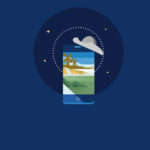Digitalization and its values
Digitalization encompasses both a process and a habitat. As a process, digitization transforms analogue content. For example, converting the 1604 edition of 'Quijote' printed by Juan de la Cuesta into a digital 'Quijote'. The content that was drawn, printed, or typed is input into a computer via numeric codes. The result can even simulate the original typography. But the letters that appear on the screen are, in reality, digits that the computer converts into images.

It's not just literary masterpieces that can be digitized. Bank accounts, climatic data, patient medical results, sheet music, texts, movies, buildings, any and all conceivable information can be digitized. This digitization process allows us to access the world around us in a different way, which in turn changes our habits and customs.
The majority of human creations can be represented digitally. The digital reproduction of a painting will not have the exact quality of the original, although we can now see the brush strokes in certain images: as in the Second Canvas Thyssen project or even being able to print a three-dimensional reproduction of a Rembrandt. Anything that can be decoded can be digitized. Thanks to this process some objects can be fully reproduced, and others mocked up. Digitization will only provide fragments in those cases where we do not know the full structure of the original object itself.
This revolution has changed the way we understand the universe. The digital arena has become the context where humans can meet each other discover the world. It heightens our senses and pushes them to new modes. For example, the incipient connectivity of neuronal networks and its interaction with machines. Coventry University’s Kevin Warwick writes about these relationships in an article for BBVA's OpenMind. In his article, he addresses cybernetics and its relationship with neuroscience.
As pointed out by Jason Bloomberg, the term is complex. Digital has developed a new meaning for the word ontology, that which the ancient philosophers referred to as the study of the very essence of things. Madrid's Prado Museum describes its own digital ontology on the web.
But does this revolution come with its own set of principles? Certainly, it asks us to rethink ethics and the new conventions for getting along in the virtual world. Without wanting to be exhaustive, there are new vales that stand out in this new world and could be of interest to mention.
- Open access to information has created a culture of administrative simplification, the elimination of barriers, and transparency. This generates a common feeling that has spread to the academic, governmental, and corporate worlds. Even more so, it has served to denounce injustice and unite humanitarian efforts on the behalf of those most in need. The digital Good Samaritan is aware of this.
- The collaborative economy's value system is related with the above. Perhaps crowdfunding is its most well-known manifestation. But its variants are many: to give product advice and opinions about places visited, to evaluate services, to share means. Companies are constantly learning from this element.
- Related to this is the ability to cultivate human relationships via digital platforms. Beyond applications used to meet people, make friends, or interact in forums, there are digital social graces. Millennials know only too well that you can have friends, meet people, and learn from them thanks to this revolution.
- Like a dream for encyclopedia lovers, digitization provides access to a wealth of information. Autodidacticism takes on a whole new dimension in the information age. With common sense and discipline, we can learn about what we never knew.
- Interacting naturally with artificial intelligence (AI) will be more and more commonplace. It’s knowing how our devices work, learning about hardware and software and distinguishing between their operating systems. This is how we work with it, we ask for its help, or play games against artificial brains. Like a group of humans who not long ago competed against various AI algorithms in the strategy game Dota 2.
- Interacting with the digital world is about being connected. It doesn't merely give us the chance to identify ourselves via digital documents. It's staying in direct contact with those who are far away, working from anywhere we want, and organizing our free time thanks to these networks. Always per the user's preference.
- And knowing how to disconnect. The recent “right to disconnect” (from work) law approved by the French government touches on this. Although, as a free option, it will depend on the individual to know how and when to disconnect. The “right to disconnect” can translate into knowing when to work and when not to.
- Digital communication has empowered many skills. From knowing how to write synthetically, including emojis and designs in our words, or starting a YouTube channel. All of this has to do with knowing how to communicate, clearly and competently.
- Because of this hyper-connectivity we have learned to be wary. On one hand, to understand the boundaries between what is public and private, and on the other to be able to identify danger in this new world: harassment, cybercrime, or fake news. It's like learning about which neighborhoods are safe and which are unsafe.
- There is a new digital appetite, which is about being able to access various styles and versions, as if the aesthetic is re-configured via the technological possibilities. This allows some artists to experiment with various forms, effects, variants, and colors. And for the rest of us, it releases the photographer, the designer, or the critic within.